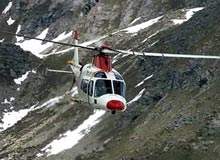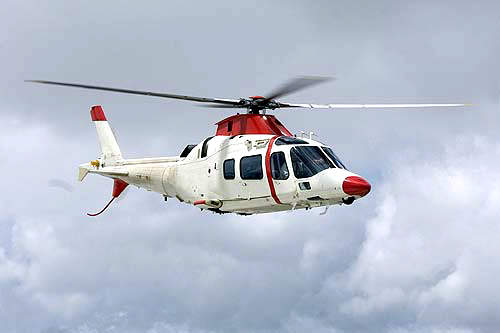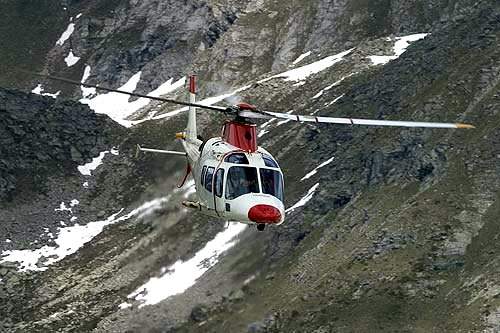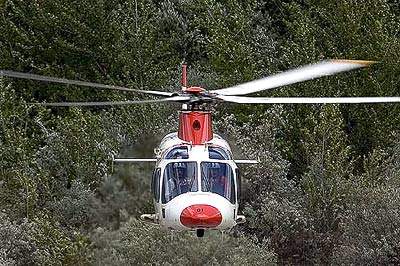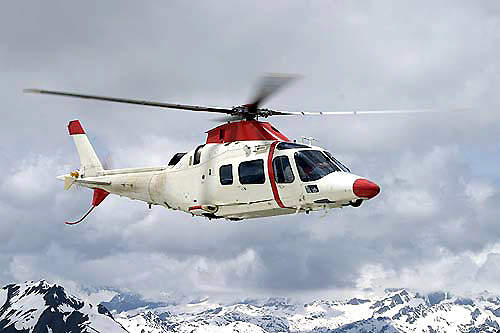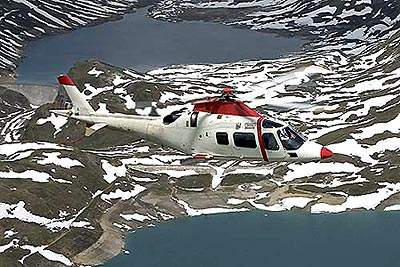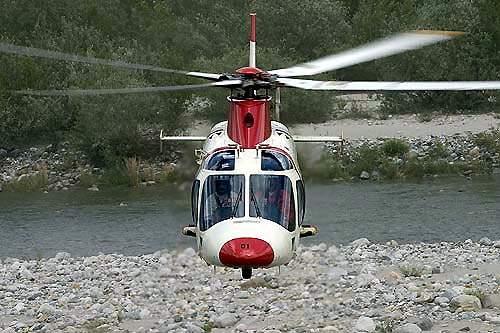AgustaWestland of Italy has developed a new light twin-turbine helicopter, the Grand, which was unveiled at the Farnborough Air Show in July 2004. The Grand can carry six passengers up to 800km.
European certification (EASA) for the Grand was awarded on 1 June 2005 and the first helicopter was delivered at the Paris Air Show on 15 June 2005.
Orders have been received for over 270 Grand helicopters from 140 customers in 30 countries. Orders include: Synergy Aerospace (four), Sloane Helicopters (seven), INAER (seven), Aerolineas Ejecutivas (five) and Heliflite (five), all ordered in February 2008.
In October 2008, the Media Luna awarded a contract to AgustaWestland for supplying one Grand light twin-turbine engine helicopter.
Kanematsu Corporation, Japan ordered two Grand twin engine helicopters, in October 2008, with deliveries scheduled for completion in 2011.
The Transnet National Port Authority (TNPA), South Africa awarded a contract to AgustaWestland in September 2008 for supplying a Grand light twin helicopter for its harbour pilot shuttle (HPS) services including marine pilot transfer operations, search and rescue missions, emergency medical evacuation and general support to international shipping.
Baxter Air of South Africa will procure one AgustaWestland Grand helicopter in VIP configuration.
In August 2008, two pilots, Scott Kasprowicz and Steve Sheik broke the world speed record for flying around the world in a helicopter in an AgustaWestland Grand helicopter. The flight took 11 days seven hours and two minutes, breaking the current record by nearly six days.
The Mexican Government ordered three Grand helicopters on 17 July 2006 for performing missions encompassing civil protection and emergency medical services. Around eight Grand helicopters were ordered by Swiss Air Rescue (REGA) on 12 September 2006 for rescue missions at high altitude and high temperature.
Seacor Holding, US ordered three Agusta Grand on 22 September 2004. AgustaWestland will supply four Grands to Airlift Northwest, US for performing emergency medical services as part of the contract signed on 27 October 2004.
AW Grand design
The Grand is a stretched derivative of the AgustaWestland A109 light helicopter.
The new main and tail rotor systems give very low external noise. The predicted approach external noise figure is 89.4dB compared to the new ICAO limit of 95dB. The predicted fly-over noise is 88.9dB, compared to the ICAO limit of 90.0dB, and the predicted take-off noise is 89.3dB compared to the ICAO limit of 92.0dB.
Safety features integrated into the helicopter include the high-strength cocoon-type airframe with a crash-resistant fuel system and crash-resistant crew and passenger seats. The Category A design includes single engine stay-up capability and system duplication and redundancy. The full Class 1 capability meets the requirements of JAR-OPS 3.
Cockpit
The cockpit has been ergonomically designed with a low-workload layout and advanced avionics for single pilot instrument flight rules capability. The customer can choose between Rockwell Collins Proline II and Honeywell King Silver Crown – Garmin avionic packages. The avionics suite includes three-axis duplex automatic flight control system (AFCS), flight director with autotrim, automatic direction finding (ADF), distance measuring equipment (DME), mode S transponder, radio altimeter, TCAS collision avoidance system and electronic flight information system (EFIS).
The cockpit can be fitted with night vision goggles (NVG) compatible internal and external lighting.
Helicopter cabin
The passenger cabin is spacious (2.3m long) and allows several cabin layouts including VIP and corporate, EMS, search and rescue (SAR) and offshore transport. The passenger cabin volume is 3.9m³ and the baggage compartment volume is 0.95m³. There is a large sliding cabin door (1.40m wide) on either sides, giving easy access to the cabin.
Six crash-resistant forward-facing seats are installed in the cabin for the offshore transport role. The customised VIP / corporate cabin layout includes luxurious five- or six-seat club-style layout with a cabinet and refrigerator.
The EMS cabin can be configured for single or dual litter (stretcher patient) layout. The single litter layout has a rotating doctor seat, a single 2m litter, a jump seat for in-flight assistance to a critical patient and two medical attendant seats. The dual litter layout includes two 2m litters and two medical attendant seats.
The helicopter can be fitted with a 1,400kg cargo hook, a double cargo hook (1,400kg and 500kg) or a 272kg external hoist.
Turboshaft engines
The helicopter is powered by two low maintenance PW207C turboshaft engines, each rated at 466kW maximum continuous power. The engines are fitted with full authority digital electronic control (FADEC) and have low specific fuel consumption and low emission of pollutants.
Single-engine contingency power rating provides 608kW for 2.5 minutes. There are three possible fuel tank configurations, with fuel capacities 460kg, 535kg and 644kg, to optimise the payload / range capability.
Performance
The maximum gross weight, 3,175kg with internal load and 3,200kg with external loads, is at the upper limit of the FAR/JAR 27 certification category.
The helicopter can climb at the rate of 9.30m a second. It has high cruise and maximum speeds of 287km/h and 311km/h respectively for the light twin / intermediate helicopter category. The maximum range and service ceiling of the helicopter are 889km and 4,940m respectively. The maximum endurance is four hours 28 minutes. A new rotor system and highly efficient engines provide low fuel burn performance.
The helicopter has excellent hover performance in hot and high conditions. At the maximum gross weight (3,175kg), the hover ceiling is 4,750m (in ground effect) and 3,050m (out of ground effect).

